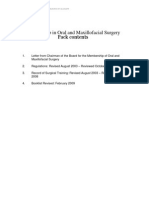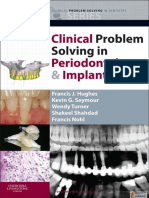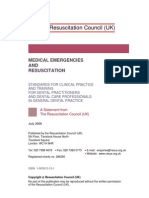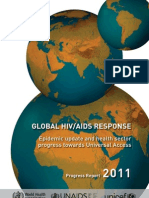Melinda Basics 3
Melinda Basics 3
Uploaded by
jesuscomingsoon2005_Copyright:
Available Formats
Melinda Basics 3
Melinda Basics 3
Uploaded by
jesuscomingsoon2005_Original Description:
Copyright
Available Formats
Share this document
Did you find this document useful?
Is this content inappropriate?
Copyright:
Available Formats
Melinda Basics 3
Melinda Basics 3
Uploaded by
jesuscomingsoon2005_Copyright:
Available Formats
Medical History
&
Periodontal Medicine
Dr Melinda Newnham Dr Melinda Newnham Dr Melinda Newnham Dr Melinda Newnham
BDSc(WA) FRACDS DCD (Perio) FRACDS (Perio) BDSc(WA) FRACDS DCD (Perio) FRACDS (Perio) BDSc(WA) FRACDS DCD (Perio) FRACDS (Perio) BDSc(WA) FRACDS DCD (Perio) FRACDS (Perio)
Medical Conditions
&
The Periodontium
Systems Check
1. CNS & special senses
2. CVS
3. Respiratory
4. Endocrine
5. Haematological
6. Dermatological
7. Musculoskeletal
8. GIT
9. Genitourinary
10. Immune system
11. Past hospitalisations and cancer history
Why Take a Medical History?
To identify systemic factors which may account for
the periodontal condition
To identify systemic conditions that require special
precautions to ensure patient safety during
periodontal therapy
To identify transmissible diseases which may
present a hazard to the clinician, dental surgery
staff or other patients
Special Precautions for Systemic
Conditions
1. Cardiovascular Diseases & Infective Endocarditis
watch BP/ adrenaline, may need antibiotic (AB) cover
2. Coagulation Disorders: managing bleeding
3. Renal Diseases
usually on immunosuppressants and may also need AB cover
4. Blood Dyscrasias: infection, ulceration & bleeding
Transmissible Diseases
Hepatitis A,B,C,D
HIV Infection
Tuberculosis
CJD
Systemic Factors which can influence
Periodontium
1. Hormonal
2. Haematological
3. Genetic
4. Smoking
5. Stress
6. Nutritional Deficiency
7. Drug-induced Gingival Overgrowth
8. Psychosomatic
Hormonal/ Endocrine
Diabetes Mellitus
Pregnancy
Puberty
Contraceptive Pill
Thyroid/ Pituitary/ Parathyroid Glands
Diabetes Mellitus
Metabolic disorder of glucose intolerance,
causing prolonged hyperglycaemia
Type 1 - decreased circulating insulin, sudden
onset, young patients (<25 yrs)
Type 2 - insulin resistance, gradual onset,
usually obese, middle-aged
Aetiology - genetic, auto-immune and ? viral
Affects ~4% of the Australian population
Diabetes Mellitus - Major Symptoms
1. 1. 1. 1. Polydipsia Polydipsia Polydipsia Polydipsia
2. 2. 2. 2. Polyuria Polyuria Polyuria Polyuria
3. 3. 3. 3. Polyphagia Polyphagia Polyphagia Polyphagia
4. 4. 4. 4. Fatigue/ weakness Fatigue/ weakness Fatigue/ weakness Fatigue/ weakness
Diabetes - Systemic complications
Affects small vessels small vessels small vessels small vessels (vascular disease).
Increased susceptibility to infection. susceptibility to infection. susceptibility to infection. susceptibility to infection.
Causes poor wound healing. poor wound healing. poor wound healing. poor wound healing.
Common Complications of
Chronic Hyperglycaemia
Retinopathy
Renal disease/ failure
Neuropathy
Cardiovascular disease
Diabetic gangrene
Increased risk & severity of
periodontal disease
Assessing Diabetic Control
Blood glucose: fasting or casual tests.
Glucose tolerance test, HbA1c.
< 6 Normal
6-8 good
8-10 mod
> 10 poor
Poorly Controlled Diabetes & Perio
1. Expect more periodontal abscesses and a poor
response to periodontal treatment.
2. Prone to infection & poor wound healing (>frequent
post-operative infection).
3. Antibiotic cover for extractions
and surgery.
4. Encourage patient to monitor/ control
their blood sugar levels.
Pregnancy, Puberty &
Contraception
Induces an exaggerated response to
plaque/ calculus.
Gingiva becomes irritated and inflamed,
often with overgrowth.
Periodontal Effects of Pregnancy
Pregnancy gingivitis:
plaque-induced gingivitis exacerbated by hormonal fluctuations in the
2
nd
& 3
rd
trimesters
Prevalence 35%-100%
Progesterone increases gingival capillary permeability & dilation
Oestrogen + progesterone change CT ground substance and
reduce keratinisation of oral epithelium
Reduces effectiveness of barrier to bacterial attack
Increased permeability of blood vessels increases exposure to and
response to plaque bacteria
Oestrogen & progesterone are used as a nutrient source for
Prevotella intermedia (Bacteroides) (Kornman & Loesche 1979)
Some subgingival plaque bacteria can use these sex steroid
hormones as growth factors
Immune Suppression
May result from a number of systemic
influences and diseases:
Infectious HIV
Therapeutic organ transplant, chemotherapy
Inherited blood dyscrasias
Neoplastic leukaemia, neutropaenias
Malnutrition Vit B and C, protein
Autoimmune SLE, Sjogrens syndrome
HIV
Associated with increased risk of certain periodontal
conditions such as Linear gingival erythema, NUG, NUP,
NUS.
There appears to be an increased incidence with
diminishing immune competence .
Linear gingival erythema Necrotizing ulcerative periodontitis
HIV & Chronic Periodontitis
Periodontitis:
Gingival recession and loss of clinical attachment appears
to occur more frequently in adult HIV patients.
But most patients with HIV can maintain periodontal health.
Highly active antiretroviral therapy (HAART):
Reduces viral loads & increases CD4+ counts (T cells).
Oral manifestations of HIV infection appear to diminish
when HAART is successful.
LGE & HIV
Prevalence 5- 49%.
2-3mm band of erythema and
oedema at gingival margin.
Gingiva bleed easily but rarely
painful.
Not associated with white cell count
(CD4+ cells).
Increased tendency to progress to
NUP.
Bacteria similar to periodontitis
but Candida albicans in 50% of cases
NUP & HIV
Prevalence 17-50%.
Rapid onset with severe pain.
Soft tissue necrosis, gingival ulceration &
cratering with bone exposure.
Gingiva bleed easily and spontaneously.
More often incisors and molars.
Hypothesised that change from LGE to NUP
associated with rapid decrease in CD4+ cell
numbers.
Haematological - Neutropenia
Varied disease group with decrease/absence
of circulating neutrophils.
Causes:
Idiopathic
Familial
Following viral, bacterial, protozoal infection and
systemic disease
Drug-induced
Periodontal manifestations of
Neutropenia:
1. Oral ulceration.
2. Gingival inflammation.
3. Rapid periodontal breakdown.
4. Alveolar bone loss.
Haematological - Leukaemia
Malignant disease involving proliferation of
leukocyte-forming tissues (especially bone marrow).
Infiltrates tissues.
May be acute or chronic.
Involves granulocytes, lymphocytes or monocytes.
Periodontal manifestations of
Leukaemia:
1. Gingival enlargement.
2. Gingival bleeding.
3. Infection.
4. Oral mucosal erosions and ulcers.
5. Bone pain.
Genetic - Downs Syndrome
Chromosomal disorder (Trisomy 21).
Incidence 1:700 (1:100 in mothers >45 years of age).
Periodontally - high incidence of disease, small conical
roots, increased in rate of destruction with age.
Aetiology - local factors:
Plaque.
Occlusal problems, habits.
Saliva and systemic factors: immune system, vascular
and nutritional factors.
Genetic - Other
Hypophosphatasia
Chediak-Higashi Syndrome
Leukocyte Adhesion Deficiency
Ehlers-Danlos Syndrome
Papillon-Lefvre Syndrome
Hereditary Gingival Fibromatosis
SMOKING
Increased bone loss, tooth loss, furcation
exposures and prevalence of periodontitis.
Severity of periodontal disease is related to
number of cigarettes smoked per day and for how
long - DOSE RESPONSE RELATIONSHIP.
Strong associations between smoking and both
aggressive and refractory periodontitis.
Smoking Clinical
1. Fibrotic gingiva with thickened, rolled margins
2. Minimal gingival redness or swelling given the disease severity
3. Relatively severe and widespread disease compared to same-
age never smokers
4. Rapid disease progression with an early onset (@ 20-30 yrs).
5. Greater pocket depths + recession in anterior and palatal sites
local effects of nicotine.
6. More bone loss especially interproximally.
7. No association between periodontal status and plaque/calculus
scores.
Smoking Mechanisms
Early studies say: no difference between smokers &
non-smokers.
Recent studies say: more pathogens in shallower sites -
>anaerobic conditions in pockets.
Microbial
Flora
Impaired neutrophil function.
Impaired fibroblast function.
Increased production & release of pro-inflammatory
cytokines.
Reduced antibody production.
Host
Response
Impairs revascularisation.
Vasoconstriction of blood vessels.
Vascular
Smoking - Outcomes
Smoking Causes Poorer Treatment Outcomes
1. Refractory Periodontitis: Up to 90% of non-
responding patients were smokers.
2. Non-surgical treatment.
3. Surgical treatment.
4. Regenerative and grafting procedures.
5. In furcations during maintenance.
Smoking Cessation
Cessation does not reverse the damage of past smoking.
However:
The rate of bone and attachment loss slows after
patients quit smoking (Bergstrom et al 2000).
Former smokers respond to non-surgical and
surgical therapy in a manner similar to non-
smokers (Kaldahl et al 1996, Grossi et al 1997).
Stress & Periodontitis
Mechanism not understood.
There is a relationship between:
Acute stress and ANUG.
Accumulation of stress events and past
periodontal breakdown.
Corticosteriods released while under stress
depress immune responses and reduce
phagocytic cell function.
Nutritional Deficiencies
Vitamin B Complex = gingivitis, glossitis
and angular cheilitis.
Vitamin C (Scurvy) = bleeding, swollen
gingiva and loose teeth.
Protein = accentuates the destructive
effects of local irritants.
Psychosomatic
Injuring the oral cavity through
development of habits
e.g. chewing pens, finger nails, smoking
pipes, or self-inflicted injuries
Drugs
&
the Periodontium
Revise: Drugs & Dentistry
1. Drugs for systemic conditions.
2. Drugs prescribed by dentists:
Local anaesthetics
Antibiotics
Analgesics
Antifungals
Calmatives/ sedatives
3. Emergency drug kit.
4. Drugs causing gingival overgrowth.
5. Bisphosphonates.
Drug-Induced Gingival Overgrowth -1
Phenytoin (Anticonvulsant)
Used in epilepsy, neuralgia and ventricular arrhythmias.
50% patients talking phenytoin get gingival overgrowth.
Overgrowth closely related to plaque control - good OH
cannot prevent hyperplasia but may reduce incidence and
severity.
Serum level closely associated with incidence and severity
dose dependent.
Proliferation of CT: both fibroblasts + collagen production.
Drug-Induced G.O. II
Cyclosporin (Immunosuppressant)
Selectively inhibits T-lymphocyte immune response.
Used to prevent graft rejection and suppress auto-
immune disease (e.g. Type 1 Diabetes, rheumatoid
arthritis, psoriasis).
Cell/ tissues similar to Phenytoin overgrowth.
Relationship between dosage, plasma levels and
hyperplasia not proven. Equivocal relationship with
plaque control.
Drug-Induced G.O. III
Calcium Channel Blockers ( BP)
Used to manage angina, hypertension and
cardiac arrhythmia.
Most common - Nifedpine and Verapamil. Nifedpine and Verapamil. Nifedpine and Verapamil. Nifedpine and Verapamil.
Nifedipine can cause hyperplasia in 15-21% of
patients:
Similar to Phenytoin hyperplasia.
Few cases described for Verapamil.
Bisphosphonates & Dentistry
Read the Dental Update 2006 review!
Basic information:
No change in protocols for NON-SURGICAL Rx.
Avoid exposing bone:
Avoid extractions promote prevention & RCT instead.
Avoid periodontal surgery including crown lengthening.
The half life of BPs is 8-10 years therefore stopping
the medication is of limited benefit.
Warn patient of potential risks if extraction
unavoidable.
Periodontal Medicine:
Perio-systemic interactions
Periodontal Disease & Systemic Disease
The effect of periodontitis is not confined to the
mouth i.e. the infection has systemic effects.
Studies in the last 10 years have shown an
association between periodontal disease and:
1. Atherosclerosis.
2. Coronary Heart Disease.
3. Stroke.
4. Pre-term low birth weight babies.
Periodontitis & Atherosclerosis
Share common risk factors:
E.g. age, male gender, smoking, fibrinogen levels,
white cell counts, haematocrit and diabetes mellitus.
Periodontitis is also associated with changes in
blood cell and biochemical markers, which are
also markers for cardiovascular disease:
E.g. clotting factors, fibrinogen, white cell counts and
C-reactive protein (CRP).
Perio-Atherosclerosis Mechanisms
1. Chronic infection Chronic infection Chronic infection Chronic infection (gram-negative bacteria in periodontitis)
causes inflammation causes inflammation causes inflammation causes inflammation:
Activated cells infiltrate into blood vessels.
Smooth muscle proliferates.
Fatty degeneration and intravascular coagulation occur.
2. LPS can increase the expression of adhesion molecules. LPS can increase the expression of adhesion molecules. LPS can increase the expression of adhesion molecules. LPS can increase the expression of adhesion molecules.
LPS from gram-negative bacteria in periodontitis can:
Cause leukocytes to infiltrate into artery walls (through
& under the tunica intima).
Affect lipid metabolism when in the blood stream
leading to atherosclerosis.
Perio-Atherosclerosis Mechanisms
3. Hyper Hyper Hyper Hyper- -- -inflammatory trait inflammatory trait inflammatory trait inflammatory trait - -- - macrophages macrophages macrophages macrophages:
Genetic or induced as a result of smoking/ infection (e.g.
periodontitis).
Activated macrophages produce excessive amounts of
pro-inflammatory molecules e.g. cytokines.
Activated cells excite other cells driving inflammation.
Patient becomes more likely to have atherosclerosis.
Influenced by periodontal disease, diet, lifestyle and
environmental factors.
Low birth weight babies
Less than 2.5kg at birth.
6-7% of all births.
Increased medical problems including:
needing neonatal intensive care.
cardiovascular, diabetes and lung disease in
adulthood.
Risk Factors for Low birth weight babies
Genetic.
Demographic:
very young or older mothers.
poor socioeconomic status.
maternal education.
Obstetric risk previous LBW babies.
Nutritional risk.
Infection - can affect gestational period.
Toxins: Smoking & Alcohol.
Infection & Inflammation
Maternal infection linked with pre-term delivery eg GUI.
Resulting in increases in levels of inflammatory mediators
triggering birth.
Fn & Pg have been found in amniotic fluid.not part of the
normal flora.
Periodontitis thought to be a significant risk factor for
pre-term birth:
There are also risk factors common to both periodontitis and pre-
term birth.
Revision for Exams
Be able to identify patients who require antibiotic cover.
Know the common drugs e.g. hypertension, asthma,
antibiotics, analgesics, anti-inflammatory medications.
Diabetes & smoking are very important risk factors for
periodontitis.
Know the 3 classes of drugs that can induce gingival
overgrowth.
Remember periodontitis has a role in CVD and pre-term low
birth weight babies by driving both inflammation & infection.
Q u e s t i o n s Q u e s t i o n s Q u e s t i o n s Q u e s t i o n s
? ? ? ? ? ? ? ? ? ? ? ?
You might also like
- QBANK PasTest SAQs For DentistryDocument651 pagesQBANK PasTest SAQs For Dentistrybassam100% (1)
- Bachelor of Dental Surgery Clinical LogbookDocument69 pagesBachelor of Dental Surgery Clinical Logbookkachy892075% (4)
- Clinical Problems in Dentistry: 50 Osces and Scrs for the Post Graduate DentistFrom EverandClinical Problems in Dentistry: 50 Osces and Scrs for the Post Graduate DentistRating: 5 out of 5 stars5/5 (1)
- SBAs and EMQs For Human Disease (Medicine) in Dentistry (2021)Document209 pagesSBAs and EMQs For Human Disease (Medicine) in Dentistry (2021)Mohammad Ibrahim100% (1)
- Fidic Users Guide A Practical Guide To The 1999 Red and Yellow BooksDocument30 pagesFidic Users Guide A Practical Guide To The 1999 Red and Yellow Booksilroy74% (19)
- Revisi Standar Akreditasi PKM 5 BABDocument23 pagesRevisi Standar Akreditasi PKM 5 BABHayuri Habita100% (1)
- Informed Consent For Hiv TestingDocument2 pagesInformed Consent For Hiv TestingMangchaaLaguna MilkTea83% (6)
- Indices For FluorosisDocument60 pagesIndices For FluorosisShameena KnNo ratings yet
- 1000 MCQs For DentistryDocument161 pages1000 MCQs For DentistryMuhsen Muneer89% (9)
- Periodontal Literature ReviewDocument70 pagesPeriodontal Literature ReviewSmitha Kapani gowdaNo ratings yet
- Crash Course in EndodonticsDocument105 pagesCrash Course in Endodonticszakarya hasaninNo ratings yet
- PasTest Online EMQsDocument283 pagesPasTest Online EMQsDental Knowledge SchoolNo ratings yet
- OSCE ExamDocument2 pagesOSCE Examaram meyedyNo ratings yet
- MOMS Application Information - New FormatDocument33 pagesMOMS Application Information - New Formatbluberry00100% (3)
- MFDS Questions ImpDocument8 pagesMFDS Questions ImpalkaNo ratings yet
- RACDS OSCE - General DentistryDocument16 pagesRACDS OSCE - General DentistryGujapaneni Ravi Kumar91% (11)
- Clinical Problem Solving in Periodontology and Implantology-01Document195 pagesClinical Problem Solving in Periodontology and Implantology-01Reman DhakalNo ratings yet
- The Dental Foundation Interview Guide: With Situational Judgement TestsFrom EverandThe Dental Foundation Interview Guide: With Situational Judgement TestsNo ratings yet
- Management of Complications in Oral and Maxillofacial SurgeryFrom EverandManagement of Complications in Oral and Maxillofacial SurgeryRating: 2 out of 5 stars2/5 (2)
- Making Health PolicyDocument213 pagesMaking Health PolicyNurhikmah Rn100% (4)
- OSCEs For DentistryDocument3 pagesOSCEs For DentistryDame rohana50% (2)
- OSCE7Document89 pagesOSCE7mghiami67% (3)
- Dental Implantology and Biomaterial (PDFDrive)Document191 pagesDental Implantology and Biomaterial (PDFDrive)Maier OlimpiuNo ratings yet
- OSCEs For DentistryDocument3 pagesOSCEs For DentistryMohammed Issa100% (1)
- Successful Panoramic Radiography: KODAK Dental Radiography SeriesDocument24 pagesSuccessful Panoramic Radiography: KODAK Dental Radiography SeriesVishakha SabooNo ratings yet
- $pediatric Dentistry dd2011-2012 DR GhadeerDocument96 pages$pediatric Dentistry dd2011-2012 DR GhadeerGhadeerHassaanNo ratings yet
- Comm Dent MCQDocument8 pagesComm Dent MCQoss-20502745100% (1)
- Dental AuxiliariesDocument14 pagesDental Auxiliariesnaina100% (1)
- Endodontics PDFDocument10 pagesEndodontics PDFShikhaNo ratings yet
- Perio Notes CombinedDocument71 pagesPerio Notes CombinedHayley WelshNo ratings yet
- (DD13-14) Dental AnatomyDocument443 pages(DD13-14) Dental AnatomyJacobsen RichardNo ratings yet
- Endo NotesDocument184 pagesEndo NotesSOMVIR KUMARNo ratings yet
- What After BDS Career OptionsDocument10 pagesWhat After BDS Career OptionsDENTALORG.COM100% (1)
- Mark The Correct Answer On The Scantron Answer Sheet.: 2 Points Per QuestionDocument15 pagesMark The Correct Answer On The Scantron Answer Sheet.: 2 Points Per Questionchakriy9No ratings yet
- Mfds ContentDocument7 pagesMfds ContentDr-Mohamed Kandeel100% (2)
- Jhon Nabil500 Qs-2Document115 pagesJhon Nabil500 Qs-2Vipin SreekumarNo ratings yet
- QBANK PasTest Best of Fives For DentistryDocument165 pagesQBANK PasTest Best of Fives For DentistrylindajenhaniNo ratings yet
- Sample-Questions-Part 2-OSCE PDFDocument10 pagesSample-Questions-Part 2-OSCE PDFaram meyedy100% (1)
- 4 - Diagnosis and Treatment PlanningDocument8 pages4 - Diagnosis and Treatment PlanningPrince Ahmed100% (1)
- Australian Dental Journal: Rhinosinusitis in Oral Medicine and DentistryDocument7 pagesAustralian Dental Journal: Rhinosinusitis in Oral Medicine and DentistryVishakha SabooNo ratings yet
- INBDE Test Specifications, by Clinical Component Section: Diagnosis and Treatment Planning Practice and ProfessionDocument3 pagesINBDE Test Specifications, by Clinical Component Section: Diagnosis and Treatment Planning Practice and ProfessionHanin AbukhiaraNo ratings yet
- Oral Pathology Lec - 1Document25 pagesOral Pathology Lec - 1مصطفى محمدNo ratings yet
- Integrated National Board Dental Examination (INBDE) 2020 Candidate GuideDocument31 pagesIntegrated National Board Dental Examination (INBDE) 2020 Candidate GuideHanin AbukhiaraNo ratings yet
- ADC Books ImportantDocument2 pagesADC Books ImportantJats_Fru_1741No ratings yet
- ADC Books Important Part 2Document2 pagesADC Books Important Part 2Jats_Fru_1741No ratings yet
- Best of Fives MCQDocument16 pagesBest of Fives MCQSalem Rawashdah0% (2)
- PDF Mcqs in Dentistry For Android 201109133336Document65 pagesPDF Mcqs in Dentistry For Android 201109133336Gloria JaisonNo ratings yet
- Manals SDLE Important PointsDocument63 pagesManals SDLE Important PointslinahouhouNo ratings yet
- Best of Fives For DentistryDocument119 pagesBest of Fives For Dentistryioana373283% (6)
- Dental EmergenciesDocument41 pagesDental Emergenciesemancipation1506No ratings yet
- Furcation 31 12 14Document25 pagesFurcation 31 12 14Ahmed BadrNo ratings yet
- 14 Techniques of Mandibular AnesthesiaDocument27 pages14 Techniques of Mandibular Anesthesiaapi-3711066100% (7)
- NATIONAL DENTAL BOARDS (NDB) / PART I: Passbooks Study GuideFrom EverandNATIONAL DENTAL BOARDS (NDB) / PART I: Passbooks Study GuideRating: 1 out of 5 stars1/5 (1)
- Restorative Dentistry: An Integrated ApproachFrom EverandRestorative Dentistry: An Integrated ApproachRating: 4 out of 5 stars4/5 (1)
- Cuspid Volume 2: Clinically Useful Safety Procedures in DentistryFrom EverandCuspid Volume 2: Clinically Useful Safety Procedures in DentistryRating: 3 out of 5 stars3/5 (1)
- Adel Lecture 3Document6 pagesAdel Lecture 3jesuscomingsoon2005_No ratings yet
- 20 Failures of Individual Restorations N Their ManagementDocument18 pages20 Failures of Individual Restorations N Their Managementjesuscomingsoon2005_No ratings yet
- Open Drainage or NotDocument6 pagesOpen Drainage or Notjesuscomingsoon2005_No ratings yet
- Fee Schedule 2HJGHGFHFDocument2 pagesFee Schedule 2HJGHGFHFjesuscomingsoon2005_No ratings yet
- FM 22-51 - Leader's Combat Stress Manual - GlossaryDocument2 pagesFM 22-51 - Leader's Combat Stress Manual - GlossarychasaNo ratings yet
- rHIVda F 001 Assessment Tool ChecklistDocument12 pagesrHIVda F 001 Assessment Tool ChecklistsomarjnovagenNo ratings yet
- Cerumen Management PDFDocument10 pagesCerumen Management PDFHimawan WidyatmikoNo ratings yet
- Allianz Diabetic Essential Brochure Translated FADocument17 pagesAllianz Diabetic Essential Brochure Translated FAEunice AbrahamNo ratings yet
- Sexual Behavior of Men Who Have Sex With MenDocument32 pagesSexual Behavior of Men Who Have Sex With MenThomas OfemNo ratings yet
- L.P of CHCDocument18 pagesL.P of CHCKiranNo ratings yet
- CFGB Proposal Sample For Food Security Project - Conservation Farming (Final Version - November 2011) PDFDocument31 pagesCFGB Proposal Sample For Food Security Project - Conservation Farming (Final Version - November 2011) PDFabel_kayel100% (2)
- Biopure Market Potential Exercise Suggested SolutionDocument4 pagesBiopure Market Potential Exercise Suggested Solutionargand_xw9097No ratings yet
- HLD Sciatica SummaryDocument6 pagesHLD Sciatica SummaryDaniel raja SotardodoNo ratings yet
- TheBreathOfLife HQ 282pgDocument293 pagesTheBreathOfLife HQ 282pgJolly Man100% (2)
- Fever and Rash in The Immunocompetent PatientDocument62 pagesFever and Rash in The Immunocompetent PatientsunilchhajwaniNo ratings yet
- The X-Files - 2x04b - UntouchableDocument63 pagesThe X-Files - 2x04b - UntouchableSpedisOwlNo ratings yet
- PHPAI BLA Checklist FinalDocument4 pagesPHPAI BLA Checklist FinalASHENAFI LEMESANo ratings yet
- OISCA Internationa2Document10 pagesOISCA Internationa2manuNo ratings yet
- Susruthasamhitha Part 1 PDFDocument22 pagesSusruthasamhitha Part 1 PDFDr Suvarna NalapatNo ratings yet
- Etiology, Classification and Clinical Approach: EndophthalmitisDocument42 pagesEtiology, Classification and Clinical Approach: EndophthalmitisHieLdaJanuariaNo ratings yet
- Hiv Full Report 2011Document229 pagesHiv Full Report 2011UNICEF Sverige100% (1)
- MAPEH2Document4 pagesMAPEH2jay meilyNo ratings yet
- West Bengal Clinical Establishments (Registration and Regulation) Act, 2010Document27 pagesWest Bengal Clinical Establishments (Registration and Regulation) Act, 2010Latest Laws TeamNo ratings yet
- dc2019 0497Document6 pagesdc2019 0497frenzybabyNo ratings yet
- The Sex Industry in Western AustraliaDocument55 pagesThe Sex Industry in Western Australiaantonia_bordoniNo ratings yet
- Viral ReplicationDocument26 pagesViral ReplicationJhann100% (1)
- Ao2019 0026 PDFDocument5 pagesAo2019 0026 PDFSAMUEL AUSTRIANo ratings yet
- FCM Platinum ReviewerDocument24 pagesFCM Platinum ReviewerJorelle MarquezNo ratings yet
- Your Online Nursing Notes : Addison'S Disease Basic InfoDocument4 pagesYour Online Nursing Notes : Addison'S Disease Basic InfoseigelysticNo ratings yet
- National Health PolicyDocument29 pagesNational Health PolicyT Uday Aditya100% (3)





























































































